The Best Audio Editing Software: 11 Audio Editors for Any Situation
- Get link
- X
- Other Apps
In order to create a podcast, cut the pauses out of a webinar recording, or add effects to a video soundtrack, you'll need audio editing software. Which audio editor you choose ultimately depends on a few factors: what you'll be using the editor for, your overall skill level, and your budget.
There's no one-size-fits-all audio editor, but there also isn't a shortage of options. After testing dozens of tools, here we'll present the 11 best audio editors for a variety of use cases.
What Makes a Great Audio Editor?
The best audio editors are designed purely with audio editing in mind. Many digital audio workstations (DAWs) include audio editing features but are ultimately designed with music production in mind. We've chosen only true audio editors for inclusion in this piece. You won't find packages like GarageBand, Ableton Live, or Pro Tools on this list.
Every editor we've chosen has a full set of basic editing controls. This is the bread and butter of audio manipulation, including recording from a microphone, selecting audio on a waveform, copying and pasting, and deleting audio from the timeline. You should be able to use any of these apps to trim an audio file down to size or merge two files together. These kinds of simple waveform edits are often referred to as destructive editing, where edits you make to the file overwrite the original when you click Save.
We've selected a variety of apps that bring something unique to the table. Not all of these features are essential to everyone looking for audio editing software, and your final decision will depend on the task at hand and your overall level of expertise:
-
Some apps make it easy for the less experienced audio editor. An uncluttered interface and simple workflow ensure unnecessary features don't get in the way of the basics. Some editors take this a step further and handle audio levels for you. Others offer one-click repairs to remove hiss and pops from your recording.
-
For more complex projects, a multi-track editor may be required. These may support the recording of multiple sources at once or non-destructive clip-based edits. You might find these features handy if you're putting together a podcast and want to use sound effects or background music alongside your primary audio track. They also use more system resources than simple destructive waveform editing.
-
Audio editing isn't just about recording and moving around sound files. Effects are useful for repairing and enhancing your audio too. These include compressing tracks to smooth out recordings that vary in volume, using an equalizer to boost or cut particular frequencies, and applying filters that drastically change the sound of your file. Some editors even support external effects via plugins.
-
If you're editing audio for use in a broadcast, adherence to common broadcast standards should make life easier. The ability to manipulate and mix audio into a video file—known as "muxing"—removes the need to render large video files for small audio edits.
-
Lastly, support for a wide array of audio files and formats may be important to some users. Simple editors only deal in basic uncompressed waveform audio (WAV) and common lossy formats (MP3, AAC). Others specialize in compressed lossless files (FLAC, Apple Lossless) and less common lossy formats (OGG, MPC).
The 11 Best Audio Editors
- Adobe Audition CC (macOS, Windows) for an all-around editor at a price
- Audacity (macOS, Windows, Linux) for multi-track editing and recording for free
- ocenaudio (macOS, Windows, Linux) for simple, fast edits for free
- Acoustica Standard Edition (macOS, Windows) for creating and deploying effect chains
- Amadeus Pro (macOS) for one-click audio repair and batch operations
- Fission (macOS) for quick and simple edits on a Mac
- Hindenburg Journalist (macOS, Windows) for journalists and podcasters
- SOUND FORGE Audio Studio 12 (Windows) for Windows users on a budget
- TwistedWave Online (Web) for quick, web-based edits
- TwistedWave Mac (macOS) for multi-channel editing and effects on a Mac
- WaveLab Elements (macOS, Windows) for an alternative to Adobe Audition, without the subscription
Adobe Audition CC (macOS, Windows)
Best audio editor for those with a big budget for audio
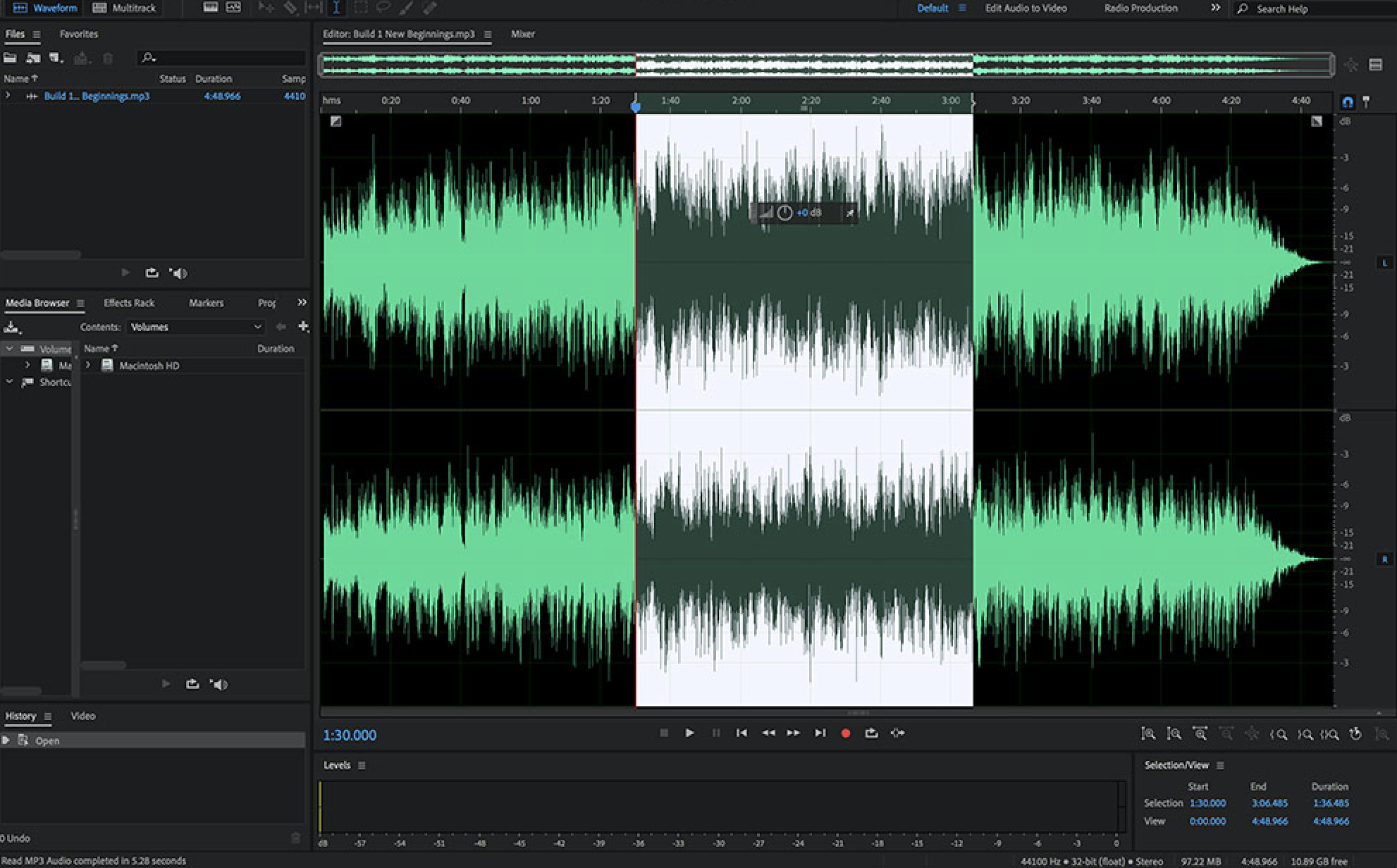
Adobe Audition CC is a powerhouse audio editor that continues to push industry standards forward, with a pricing model to match. The app is updated every year with new features and expanded compatibility with the latest versions of macOS and Windows.
Audition can function both as a single-track audio editor, and as a multi-track mixer for recording and layering sounds. The app can be used as a fully-fledged digital audio workstation with support for recording multiple sources at once as well as external plugins (VST, VST3, and AU). Adobe also added best-in-class audio restoration tools, allowing you to grab a sample of "noise" in your recording, then remove that unwanted range of sound from the entire file. You can also use adaptive noise reduction (which intelligently detects undesirable sound for you) and automatic or spot healing to remove pops and clicks.
You can save your frequently-used actions so they're always a click away under the Favorites menu. Easily change Audition's interface to suit your current task, with layouts for audio to video editing, radio production, and dual-monitor setups. All these features make Adobe Audition a highly capable, if expensive, audio editor.
Adobe Audition CC Price: $20.99/month (billed annually) for a single app plan; $52.99/month (billed annually) for a Creative Cloud plan with access to Adobe's full suite of apps, including Photoshop, Premiere Pro, and Illustrator.
Audacity (macOS, Windows, Linux)
Best audio editor for multi-track editing and recording for free

Audacity is the most capable free audio editor money can't buy. It provides users with a full set of editing and mastering tools, including destructive waveform and multi-track editing. Despite utilizing an open source development model, Audacity contains many features usually reserved for paid products.
The editor places a library of effects at your disposal including a compressor, noise reduction, and an automatic repair tool. There's also support for external audio effects and sound generator plugins in VST, AU, LADSPA, and LV2 format. Owing to its open source roots, Audacity supports the import and export of a wide range of formats like Ogg Vorbis, FLAC, and M4A.
A basic and slightly clunky interface lets it down compared to some of its rivals. You can't record multiple audio sources at once or perform non-destructive edits. Given that it comes without a price tag, we can forgive the limitations.
Audacity Price: Free
ocenaudio (macOS, Windows, Linux)
Best free editor for simple, fast edits
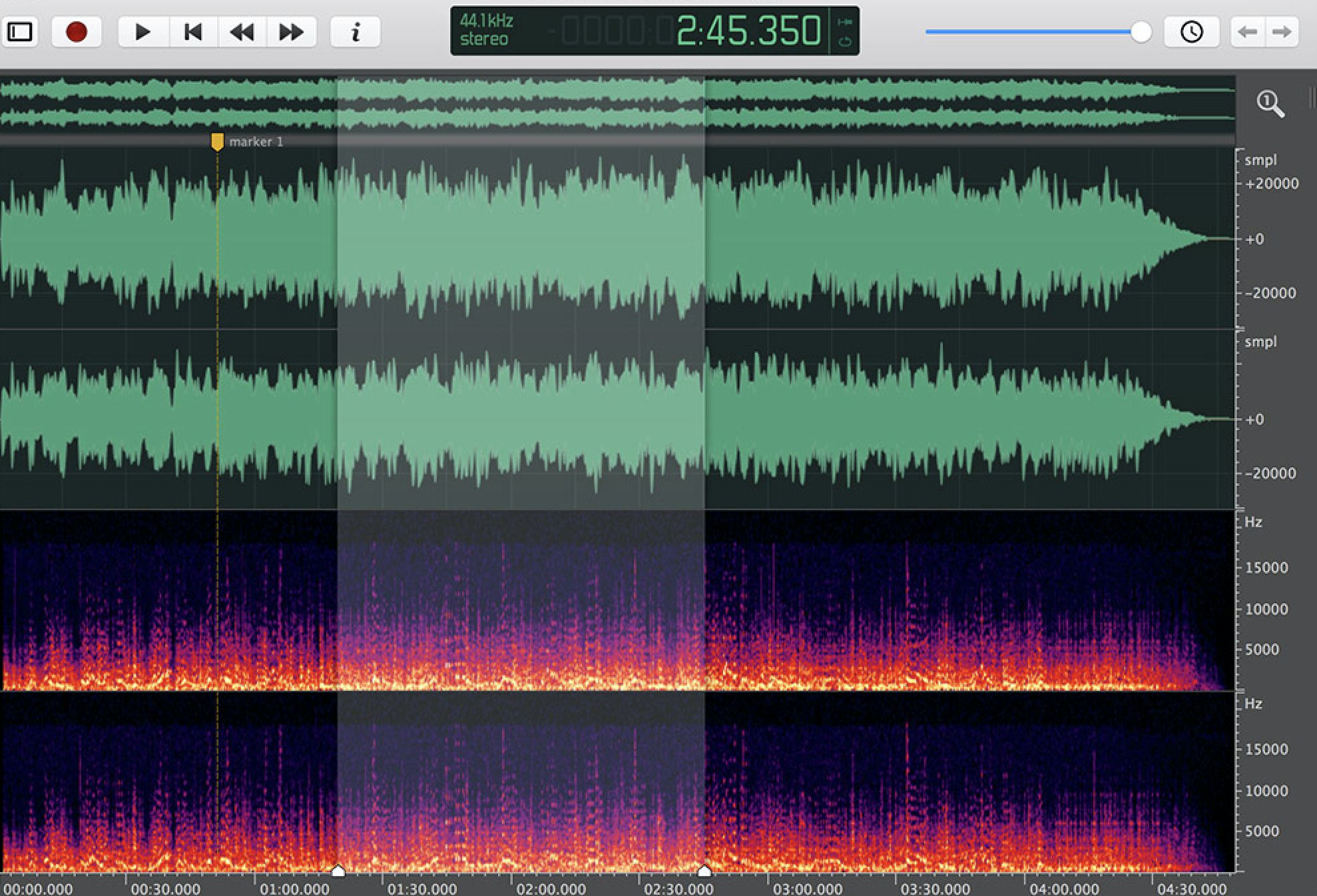
ocenaudio is a free single-track editor for making destructive edits to audio files. It's a capable all-arounder with a clean and minimal interface that sets it apart from the comparatively cluttered Audacity. Add markers to your files, make edits to specific channels, and manipulate the metadata before exporting your recording.
In addition to the basic trimming and clipboard operations, ocenaudio also includes a number of effects and support for VST plugins (and AU plugins on a Mac). These include simple noise reduction operations, filters, a 31-band equalizer, plus time and pitch adjustment. Highlight audio to get quick access to functions like cut, copy, and delete, and to see exact timecodes.
It's a simple editor, but it's perfect for users who find Audacity's interface overwhelming and clunky. Thanks to some clever memory management, ocenaudio is great for editing large files without performance taking a hit—something that's rare for free editors. If you don't need multi-track support or all of the effects and plugins included in Audacity, ocenaudio is the editor for you. It's also considerably better looking.
ocenaudio Price: Free
Acoustica Standard Edition (macOS, Windows)
Best audio editor for creating and deploying effect chains
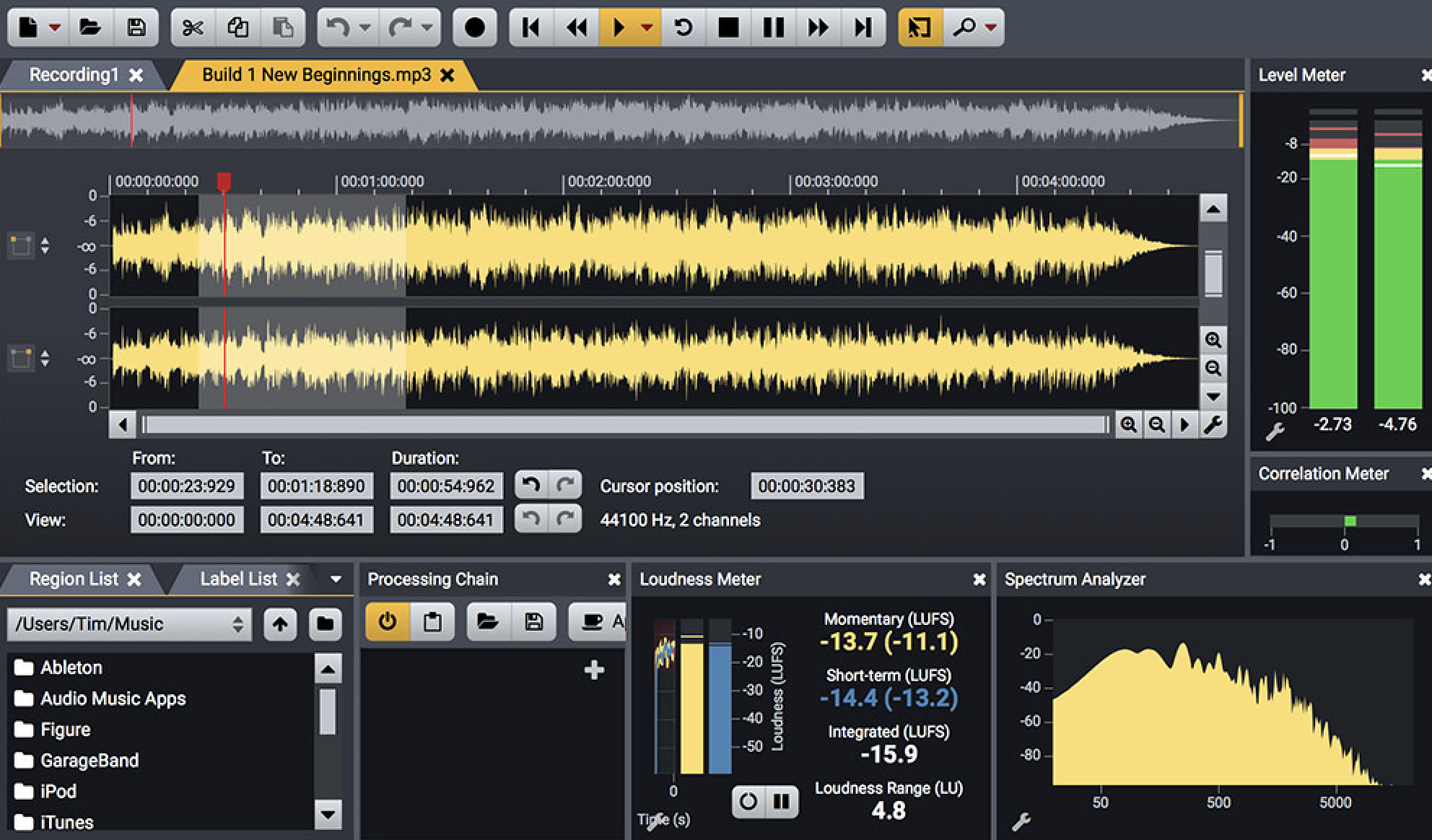
Acoustica Standard Edition offers more than your average free audio editor in a package that won't break the bank. It's a high-resolution audio editor, with support for 32 bit audio and sample rates of up to 384 kHz. You can use Acoustica for single-track waveform editing or multi-track mixing where you can loop, stretch, and fade clips on a timeline.
Basic effects include a limiter, an equalizer, and a suite of audio restoration tools for removing hiss, pop, and hum from recordings. Acoustica also includes support for external plugins in VST, VST3, and AU format. Each of these can be chained together, saved, and deployed with a click across multiple sessions and files. Build your effects in the Processing Chain box on the main interface by clicking the + button to add equalizers, limiters, plugins, and more. Acoustica is also compliant with common broadcast standards, making it easy for working with video soundtracks.
Acoustica's neat row of useful icons, dark color scheme, and tab-based interface for working on multiple files should prevent you from feeling overwhelmed by the extensive feature set. If you find yourself craving more "professional" features, the Premium Edition of Acoustica offers even better audio restoration tools, multi-channel 7.1 surround sound support, and spectral editing.
Acoustica Price: $59.90 for the Standard Edition; $199.90 for the Premium Edition
Amadeus Pro (macOS)
Best audio editor for one-click audio repair and batch operations

A self-described "swiss army knife of sound editing," Amadeus Pro is a multi-track audio editor for Mac with a focus on user-friendliness. An attractive interface displays only a handful of icons for the most basic operations, including playback controls, the record button, and a few multi-track functions like adding new tracks or splitting stereo recordings into individual tracks. Most other functions are triggered via the menu bar or a keyboard shortcut.
In addition to the basic editing operations, Amadeus includes a batch processing module for applying effects, writing metadata to, and converting multiple audio files via a simple drag-and-drop interface. Apply effects like RIAA equalization and amplification, trim silence, and suppress white noise. The app also allows you to apply plugins in AU format to a selection of files in a click.
Amadeus Pro includes a tool called Repair Center, which scans your file for imperfections and attempts to repair them for you. Head to Window > Repair Center and then click Find next to scrub through your file and fix any problems. You can listen to the repaired segment before applying it to your recording. The nature of the Repair Center tool makes it particularly easy: It's a bit like using a spell checker that scans through your document and suggests improvements. There's also a built-in burning tool for committing your recordings to CD, provided your Mac has an optical drive.
Amadeus Pro Price: $59.99
Fission (macOS)
Best audio editor for quick and simple edits on a Mac

For Mac users, Fission feels like home. It's a pure Mac app, built from the ground up with macOS in mind. This much is evident from the most basic of functions, which closely mimic Apple's desktop OS. Familiar keyboard shortcuts like command + I for showing the Inspector, pinch to zoom, and drag-and-drop functionality work just like you'd expect them to.
Fission lacks many of the effects found in its rivals. You can apply fades, normalize audio, or amplify sections, but there are no equalizers, noise reduction is absent, and plugins aren't supported. Instead, the emphasis is on lossless waveform editing, with the overall quality of your audio being Fission's main focus. There's no multi-track editing or recording of multiple inputs—this is a simple and streamlined waveform editor.
The editor includes a batch processor for converting files from one format to another. Export your audio as chapterized MP3 or AAC files by marking regions as chapters in Fission, then exporting under the File menu (or export in iPhone ringtone format). It's a simple editor, at a reasonable price point, and it's perfect if you don't want to get bogged down by features you'll never use.
Fission Price: $29
Hindenburg Journalist (macOS, Windows)
Best audio editor for journalists and podcasters
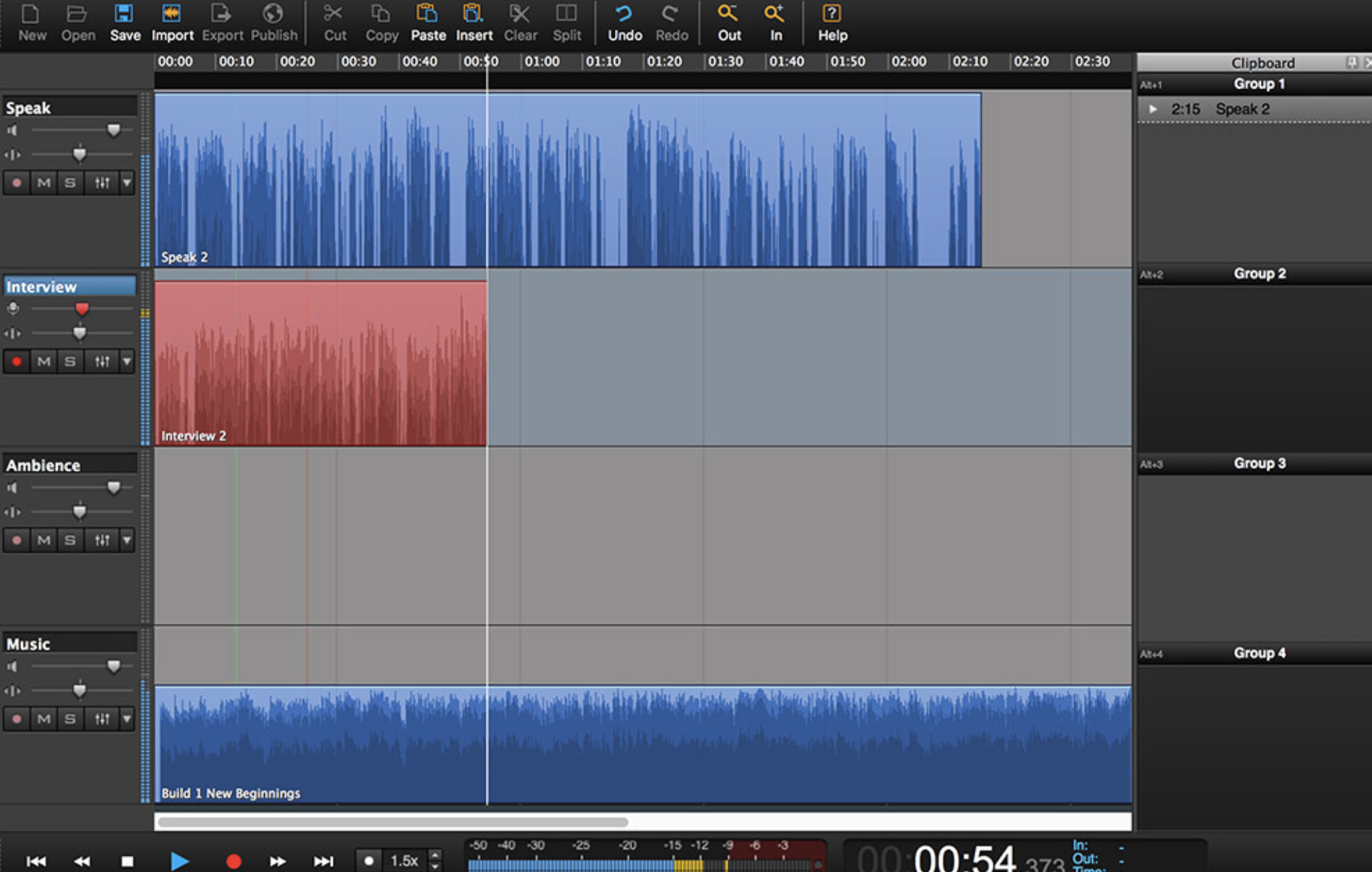
Hindenburg Journalist is a multi-track audio editor aimed at professionals who work with the spoken word. You can either record directly into the app or arrange files you've already recorded elsewhere. It's perfect for cutting together interviews or producing podcasts since it handles some of the more technical aspects of production for you.
The app's standout feature is its ability to handle levels for you. As soon as you're done recording or importing a waveform, watch Hindenburg Journalist automatically increase or decrease the volume of the track to comply with modern loudness standards. You can then use the built-in profiler, an automated equalizer for enhancing voice tracks, to optimize your audio for publishing.
Hindenburg makes it easy to create and arrange projects on a timeline. You can add markers or separate audio by chapter while recording, so you don't lose track of important sound bites. The app's clipboard function provides four groups into which you can divide your sound bites, music, ambiance, and other audio clips, with the ability to paste the top clip with a custom shortcut.
Hindenberg Journalist Price: $95
SOUND FORGE Audio Studio 12 (Windows)
Best audio editor for Windows users on a budget
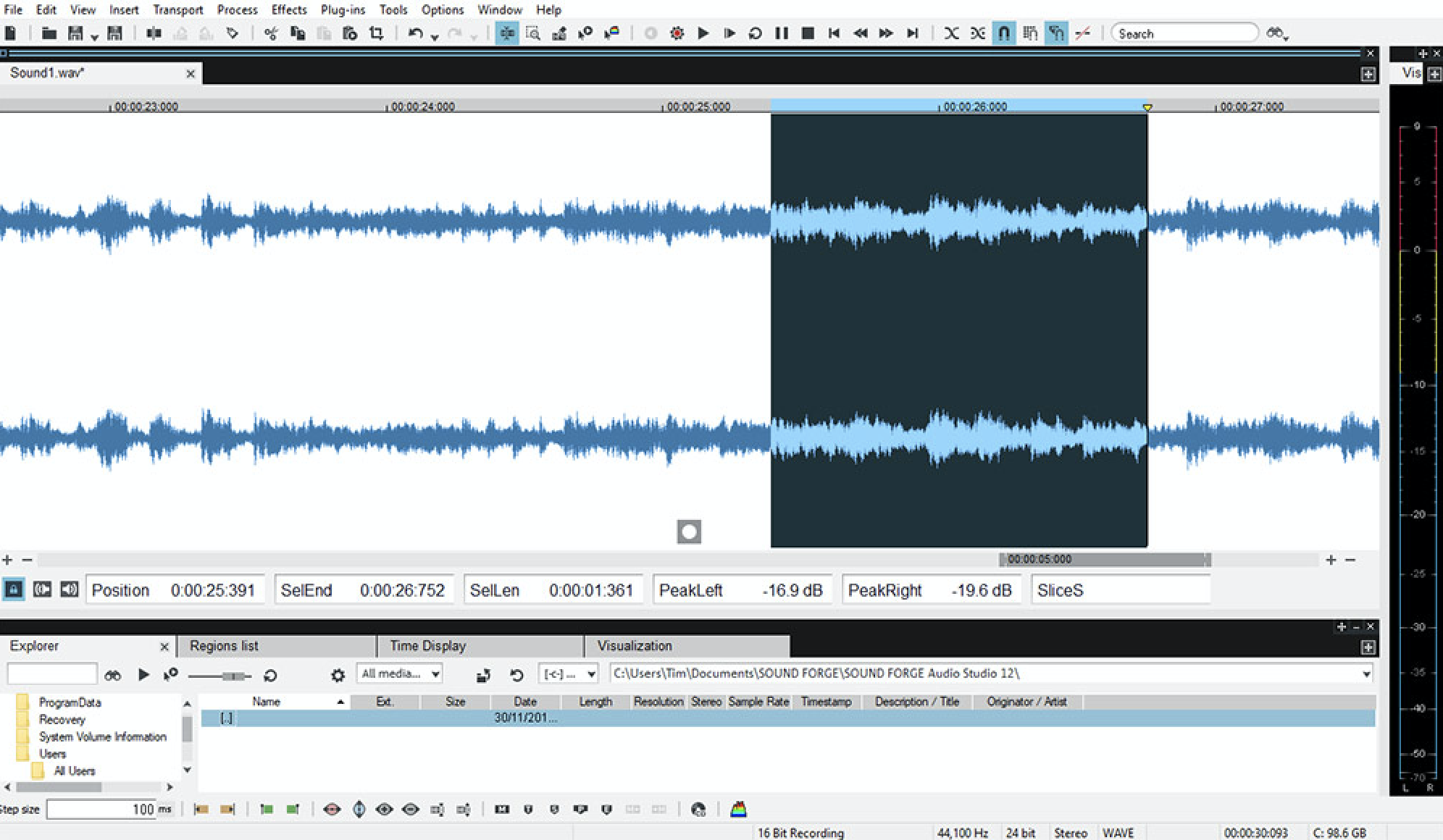
SOUND FORGE Audio Studio 12 is a moderately priced audio editor for Windows. While a version of SOUND FORGE Pro exists on the Mac, only Windows users get the cheaper Audio Studio 12. Despite the affordable price tag, Audio Studio 12 is a powerful tool for editing, mastering, and exporting audio to a variety of formats.
It's not a multi-track editor, instead focusing on a single stereo file or recording at a time. Common tasks that the app handles confidently include cutting up files, merging recordings, cleaning up audio, and applying effects. Audio Studio 12 comes with iZotope Ozone Elements, a dedicated mastering processor which runs alongside the main app as a plugin. Ozone includes professionally-designed presets to make your recordings sound richer and punchier with minimal effort.
Video integration is one of Audio Studio 12's strong points. You can open a video file and see the individual frames on the timeline while making your edits. When you've improved your soundtrack, it's easy to merge—or "remux"—that audio file back into the video, without having to take the time to re-render the whole thing.
SOUND FORGE Audio Studio 12 Price: $59.99
TwistedWave Online (Web)
Best audio editor for web-based audio editing
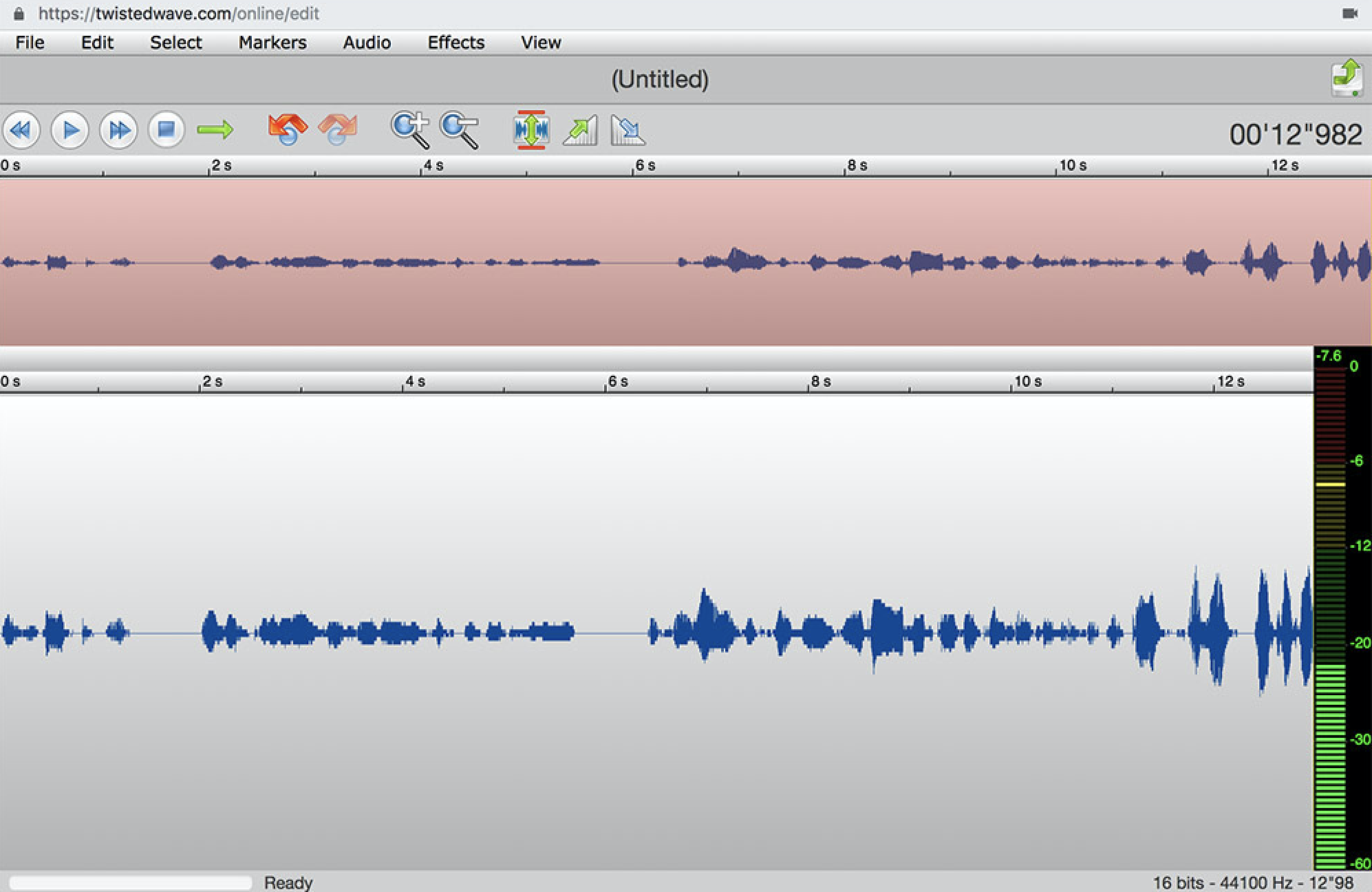
Editing audio in a browser isn't for everyone. It can be laggy, web apps tend to crash, and much of the time, the speed of your internet connection will dictate how productive you can be. With this in mind, TwistedWave Online is the best cloud-based tool for the job. The free plan is limited to five-minute mono recordings, 16 bit audio at 48kHz, with an hour of free online storage when you register an account. Sign up for the premium plans to increase these limits and enable stereo recording.
You can use TwistedWave Online to create recordings and edit files you already have. Grant access to your microphone and record directly into a browser, or upload your own files for editing. Of course, you'll have to wait for your file to upload before editing, and there can be some delays in playback while you use the app.
TwistedWave Online includes a few effects on top of the usual editing features. You can amplify audio, create fades, and change pitch or speed. You can also apply TwistedWave's own library of VST effects, which work surprisingly well for a cloud-based editor.
TwistedWave Online Price: Free; from $5/month for stereo editing, 20-minute file lengths, and 10 hours of online storage
TwistedWave Mac (macOS)
Best audio editor for multi-channel editing and effects on a Mac

TwistedWave Mac is another Mac-only editor at a premium price point. It's suitable for making quick edits to audio files, mastering audio using built-in effects, and batch processing. The interface is minimal and responsive, and applying effects or processing large files takes place in the background. This allows you to keep working while TwistedWave catches up.
Useful features include a smart silence detector, allowing you to detect silences and export the remaining audio as individual files. There's a handy batch processor for applying the many built-in effects, including VST and AU plugins supported by the app. You can also create your own effect stacks and deploy them with a single click.
Compared to a simpler editor like Fission, TwistedWave includes some more advanced features like professional time stretching and pitch shifting, multi-channel editing for 5.1 and 7.1 files, and support for up to 32 bit audio at 192 kHz.
TwistedWave Mac Price: $79.90
WaveLab Elements (macOS, Windows)
Best audio editor for an alternative to Adobe Audition, without the subscription
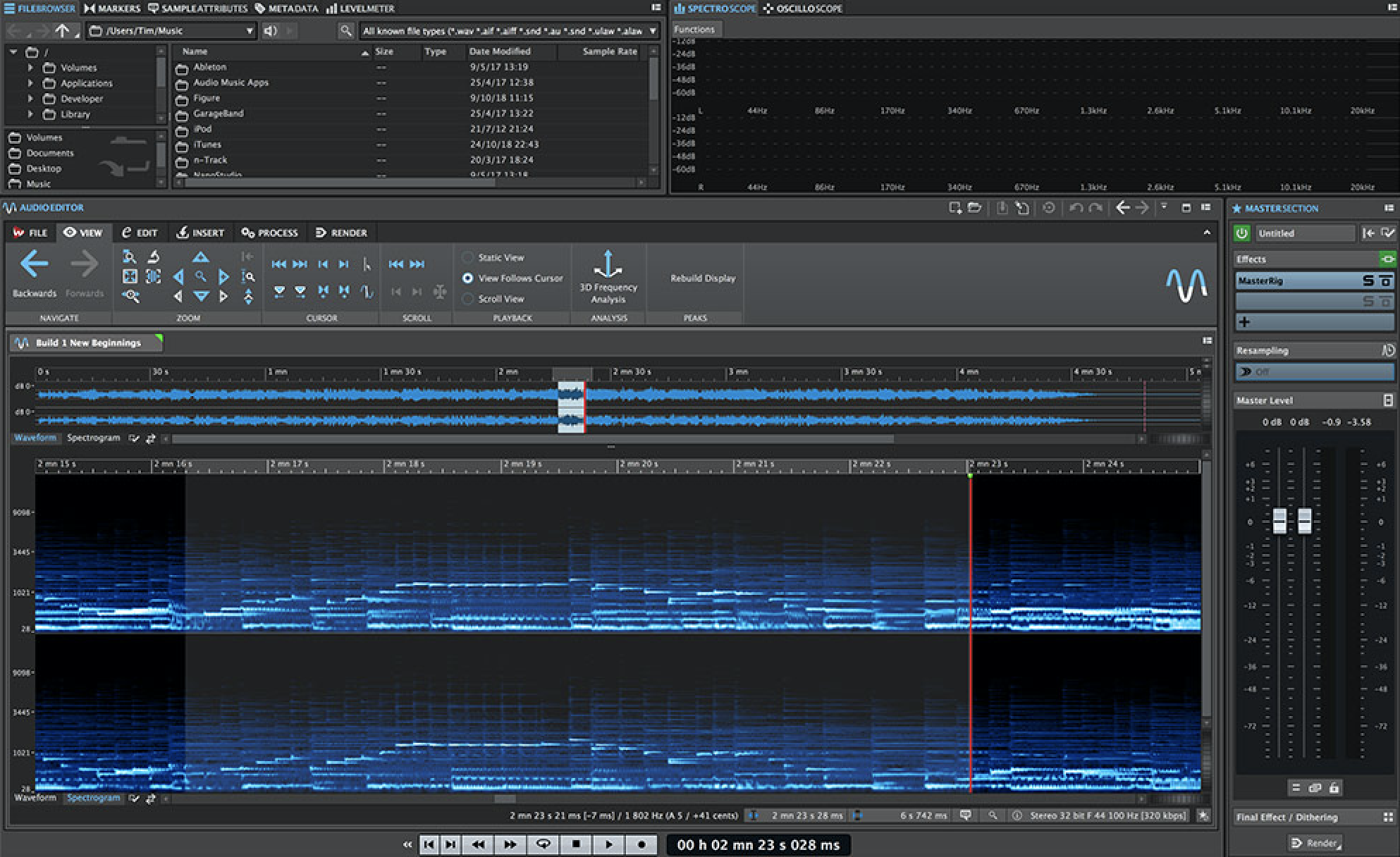
WaveLab Elements is a serious audio editor comparable to Adobe Audition. It's a cut-down version of Steinberg's much pricier WaveLab Pro, featuring a range of tools for audio visualization, editing, and mastering. Unlike Audition, WaveLab isn't a multi-track editor, but in terms of professional application, it shares many similarities including an extensive range of effects and an interface geared towards professional users.
Of note are the extensive audio visualization tools. You can edit audio on a regular waveform, or use the spectrogram view to identify specific frequencies and notes. Insert markers at any point in your recording, or mark specific regions of the recording to revisit later.
WaveLab Elements comes with a "module-based" mastering suite, which allows you to build a chain of limiters, compressors, equalizers, saturators, and stereo imagers in a single effect module. Save your customized modules for use later in other projects. It's a highly capable tool for home musicians and podcasters, without Adobe's subscription-based approach.
WaveLab Elements Price: $99
You don't need an audio editor until you need to edit audio. That means you should pick your editor of choice based on what you're trying to achieve.
Free editors like Audacity and Ocenaudio are good starting points for most users. If you're finding the free options a little limiting, budget editors like Fission provide more pleasant working environments and robust feature sets. Other premium products provide unique benefits, like Hindenburg's focus on interviews and podcasts. You can edit audio through a web browser with TwistedWave, but it's ideal only in a handful of instances.
The best tools for the job are almost always premium products, with fairly expensive price tags. Audition is an industry-standard tool, but the subscription model offers some flexibility in terms of your use. If you only need it for a month, it could be a cheap and effective route to take.
Bottom line: Choose your audio editor with your end goal in mind.
Related reading:
from The Zapier Blog http://bit.ly/2RNI9PY
- Get link
- X
- Other Apps
Comments
Post a Comment